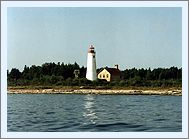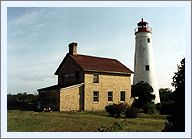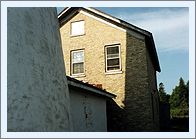|
Historical Information

Thunder Bay Island sits just three miles
East-northeast of the north point of Thunder Bay, and thirteen miles
from the harbor at Alpena. This 215-acre limestone island is the
outermost of a group of islands connected to the shore by a shallow
rocky shoal. As such, it represented both a significant marker for
Northbound vessels making the turn toward the Straits, and stood ready
to chew the wooden hulls of vessels unlucky enough to stray too close to
its rocky shores.
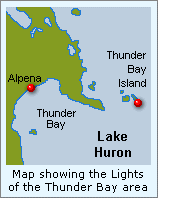 After a hearing a number of memorials
presented on behalf of maritime interests throughout the Lakes begging
that a light be placed on this important island, Congress instructed the
Commerce Committee to conduct an investigation into the need and
feasibility of the construction of such a light on January 6, 1831. At
the completion of its investigation, the Committee on Commerce responded
favorably, and Congress appropriated the necessary funds for what would
become Lake Huron's third lighthouse later that same year. After a hearing a number of memorials
presented on behalf of maritime interests throughout the Lakes begging
that a light be placed on this important island, Congress instructed the
Commerce Committee to conduct an investigation into the need and
feasibility of the construction of such a light on January 6, 1831. At
the completion of its investigation, the Committee on Commerce responded
favorably, and Congress appropriated the necessary funds for what would
become Lake Huron's third lighthouse later that same year.
A site for the station was selected on
flat ground approximately 1,200 feet from the Southeastern point of the
island, and in accordance with policy, bids were advertised for its
construction. The contract was awarded to Detroit builder Jeremiah
Moors, and as was the case in almost all lighthouse construction on the
Lakes during these early years, costs were kept as low as possible
through the use of construction material found at the site. With a ready
supply of limestone on the island, it is no surprise that limestone
rubble was used extensively throughout the construction. Through the
1831 season of navigation, Moors' crew built a forty foot tall tower and
detached 1½-story keeper's dwelling. While we have been thus far unable
to locate either written specifications or plans for the structure, it
is reasonable to speculate that it was similar in design to the station
built at New Buffalo which was built seven years later in 1839 for which
we have been able to find complete specifications. We do know that the
tower stood 21 feet in diameter at the base, and tapered to a diameter
of 11 feet 4 inches at the top, and was almost certainly capped with a
birdcage-style lantern and Lewis lamp array in exclusive use at that
time. Joseph Duchene was chosen as the station's first keeper, and is
listed as officially taking office at the station on February 1, 1832,
and after arriving on the island Duchene officially exhibited the light
for the first time at an unrecorded date later that spring. Apparently
Duchene was not well suited for the rigors of island light-keeping, as
payroll records indicate that he resigned his position after only three
months on May 1, to be replaced by Jesse Muncey.
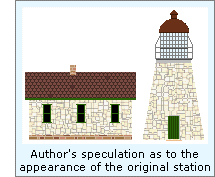 Evidently, the tower did not last much
longer than its first keeper, since Congressman Austin Wing presented a
petition to Congress on Jeremiah Moors' behalf on January 26, 1834
requesting that Moors be reimbursed for additional expenditures incurred
at the station after it "fell in consequence of being located on a
site unfit for the same." This collapse of the original tower was
later mentioned by Lieutenant James T Homans in his 1838 annual report
on the condition of Great Lakes Lights, when after visiting the station
on November 15, he reported that the tower was in "a critical
situation, and may, if not soon protected by some barrier, share the
fate of one formerly near this site." Homans then went on to report
that he found the lake lapping at the tower's foundation, and
recommended that $800 be immediately allocated for the construction of
stone-filled timber cribs to protect the base of the tower from being
undermined and toppling once more. As a longer term solution, and adding
credence to Moors' claim that the site selected by the Government was
unfit, Homans also recommended that the station be completely rebuilt on
higher ground to the rear of the original site. It appears that the
wooden cribs were successful in stemming the erosion, since after
visiting the station on July 3, 1850, Henry B, Miller the Superintendent
and Inspector of Lights of the Western Lakes reported only that
"Everything here is in good order." Evidently, the tower did not last much
longer than its first keeper, since Congressman Austin Wing presented a
petition to Congress on Jeremiah Moors' behalf on January 26, 1834
requesting that Moors be reimbursed for additional expenditures incurred
at the station after it "fell in consequence of being located on a
site unfit for the same." This collapse of the original tower was
later mentioned by Lieutenant James T Homans in his 1838 annual report
on the condition of Great Lakes Lights, when after visiting the station
on November 15, he reported that the tower was in "a critical
situation, and may, if not soon protected by some barrier, share the
fate of one formerly near this site." Homans then went on to report
that he found the lake lapping at the tower's foundation, and
recommended that $800 be immediately allocated for the construction of
stone-filled timber cribs to protect the base of the tower from being
undermined and toppling once more. As a longer term solution, and adding
credence to Moors' claim that the site selected by the Government was
unfit, Homans also recommended that the station be completely rebuilt on
higher ground to the rear of the original site. It appears that the
wooden cribs were successful in stemming the erosion, since after
visiting the station on July 3, 1850, Henry B, Miller the Superintendent
and Inspector of Lights of the Western Lakes reported only that
"Everything here is in good order."
With the area frequently enveloped in
thick fogs and snow squalls making the light impossible to see, Congress
appropriated $2,500 for the installation of a fog bell on the island on
March 3, 1853, and the newly formed Lighthouse Board dispatched a survey
crew to the island to select a site and make the necessary plans for
construction the following spring.
Although more than twenty years had
passed since the construction of the original tower, it would appear
that the matter of Moors' losses involved in rebuilding the tower
remained unresolved, as Senator Lewis Cass took up Moors' cause on
January 3, 1855, presenting a petition on the builder's behalf
"praying compensation for services rendered and losses sustained in
the construction of a light-house on Big Thunder Bay island." Two
months later on March 3, the Thunder Bay Island fog signal was finally
placed into service.
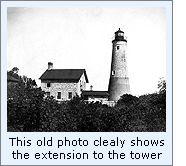 With rapidly increasing maritime
traffic through the 1850's, the Lighthouse Board determined that the
combination of inefficient Lewis lamps and the diminutive 40-foot height
of the tower provided a less than effective aid to mariners relying on
this important station. To rectify the situation, plans were formulated
to increase the height of the tower and to install an improved French
Fresnel lenses of the type currently being installed throughout the
system. Over 1857, the upper 14 feet of the tower was encased in brick
and continued above the upper limits of the old structure to a height of
50 feet, effectively increasing the total height of the tower by 10
feet. The entire exterior of the tower was then given a veneer of Cream
City brick to provide a smooth, weather-proof surface. At completion of
the masonry work, the renewed walls at the base of the tower stood a
massive 79 inches thick, and tapered to a thickness of 20 inches at
their uppermost. Atop this renovated tower, a new gallery with a cast
iron hand railing was installed, and a ten-sided prefabricated cast iron
lantern installed at its center. Within this new lantern, a Fourth Order
Fresnel lens manufactured by Sautter of Paris equipped with six
bulls-eye flash panels was installed on a cast iron pedestal and
equipped with a clockwork rotating mechanism. This new improved
illuminating apparatus provided a characteristic fixed white light
varied by flashes, and its enhanced focal plane of 59 feet provided an
increased range of visibility of 14 miles at sea. With rapidly increasing maritime
traffic through the 1850's, the Lighthouse Board determined that the
combination of inefficient Lewis lamps and the diminutive 40-foot height
of the tower provided a less than effective aid to mariners relying on
this important station. To rectify the situation, plans were formulated
to increase the height of the tower and to install an improved French
Fresnel lenses of the type currently being installed throughout the
system. Over 1857, the upper 14 feet of the tower was encased in brick
and continued above the upper limits of the old structure to a height of
50 feet, effectively increasing the total height of the tower by 10
feet. The entire exterior of the tower was then given a veneer of Cream
City brick to provide a smooth, weather-proof surface. At completion of
the masonry work, the renewed walls at the base of the tower stood a
massive 79 inches thick, and tapered to a thickness of 20 inches at
their uppermost. Atop this renovated tower, a new gallery with a cast
iron hand railing was installed, and a ten-sided prefabricated cast iron
lantern installed at its center. Within this new lantern, a Fourth Order
Fresnel lens manufactured by Sautter of Paris equipped with six
bulls-eye flash panels was installed on a cast iron pedestal and
equipped with a clockwork rotating mechanism. This new improved
illuminating apparatus provided a characteristic fixed white light
varied by flashes, and its enhanced focal plane of 59 feet provided an
increased range of visibility of 14 miles at sea.
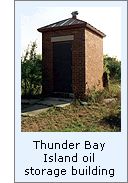 While the renewed tower continued to
serve admirably, over the ensuing years the condition of the rubble
stone dwelling deteriorated badly, and even though frequent repairs had
been made, the Board recommended an appropriation of $8,000 to replace
the aging structure in its annual report of 1866. Congress responded
favorably with the requested appropriation on March 2 of the following
year, and a crew arrived on the island in 1868 to demolish the old
structure and build a new two-story dwelling of the same Cream City
brick used in the 1857 tower reconstruction. On completion, the
hip-roofed dwelling stood 43 feet by 28 feet in plan, and was connected
directly to the tower by an enclosed brick passageway, affording the
keepers with welcome shelter during their frequent trips to the tower on
cold and stormy nights, along with additional storage space for the many
cleaning and maintenance supplies used in the day to day maintenance of
the station's illuminating apparatus. While the renewed tower continued to
serve admirably, over the ensuing years the condition of the rubble
stone dwelling deteriorated badly, and even though frequent repairs had
been made, the Board recommended an appropriation of $8,000 to replace
the aging structure in its annual report of 1866. Congress responded
favorably with the requested appropriation on March 2 of the following
year, and a crew arrived on the island in 1868 to demolish the old
structure and build a new two-story dwelling of the same Cream City
brick used in the 1857 tower reconstruction. On completion, the
hip-roofed dwelling stood 43 feet by 28 feet in plan, and was connected
directly to the tower by an enclosed brick passageway, affording the
keepers with welcome shelter during their frequent trips to the tower on
cold and stormy nights, along with additional storage space for the many
cleaning and maintenance supplies used in the day to day maintenance of
the station's illuminating apparatus.
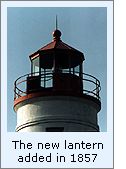 Although the Board stated that the
station was good condition in its 1858 annual report, the lighthouse reservation's location on low land
still represented some problem for the station's keepers,
as it was reported that the floor of the new covered way was frequently
covered with water, and as a result, plans were drawn-up to elevate the
floor above the water level during the following year. Although the Board stated that the
station was good condition in its 1858 annual report, the lighthouse reservation's location on low land
still represented some problem for the station's keepers,
as it was reported that the floor of the new covered way was frequently
covered with water, and as a result, plans were drawn-up to elevate the
floor above the water level during the following year.
While the fog bell installed on the
island in 1855 represented the state of the art in fog signal technology
at the time, great strides had been made in steam-operated systems over
the ensuing years. The ear shattering screams emitted by these
steam-powered whistles carried infinitely further through thick weather
than the largest of bells, and as a result of the great importance
placed on the Thunder Bay Island station by mariners, the decision was
made to replace the old bell with duplicate steam whistles in 1870.
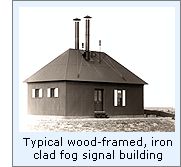 A work crew and materials were
delivered on the island in 1871, and construction began on a wooden
frame fog signal building covered on the interior and exterior with iron
sheets, and the installation of the "screaming demons"
themselves. The power plant consisted of a pair of horizontal
locomotive-type boilers, each plumbed into its own ten-inch steam
whistle located on the exterior wall of the signal building. As was the
case with the light at each station, each fog signal was set up to
sound-out a pattern of blasts and silence unique to that station,
allowing mariners to be able to pinpoint their location in thick weather
from the unique sounds around them. The Thunder Bay Island fog signal's
characteristic was set to provide a repeated one-minute cycle consisting
of a blast of 8 seconds followed by a silent interval of 10 seconds,
then a blast of 2 seconds, followed by 40 seconds of silence. This cycle
was repeated endlessly as long as the keeper determined that visibility
dictated its activation during fog, snow squalls or periods of smoke
resulting from the frequent forest fires of the time. A work crew and materials were
delivered on the island in 1871, and construction began on a wooden
frame fog signal building covered on the interior and exterior with iron
sheets, and the installation of the "screaming demons"
themselves. The power plant consisted of a pair of horizontal
locomotive-type boilers, each plumbed into its own ten-inch steam
whistle located on the exterior wall of the signal building. As was the
case with the light at each station, each fog signal was set up to
sound-out a pattern of blasts and silence unique to that station,
allowing mariners to be able to pinpoint their location in thick weather
from the unique sounds around them. The Thunder Bay Island fog signal's
characteristic was set to provide a repeated one-minute cycle consisting
of a blast of 8 seconds followed by a silent interval of 10 seconds,
then a blast of 2 seconds, followed by 40 seconds of silence. This cycle
was repeated endlessly as long as the keeper determined that visibility
dictated its activation during fog, snow squalls or periods of smoke
resulting from the frequent forest fires of the time.
While the Thunder Bay Light served as
an adequate warning to mariners, it could not completely prevent vessels
from running into distress, and after a number of wrecks occurred in the
area, a lifesaving station was established 3/8 of a mile west of the
Light in 1876.
In another vindication of Moors' claims
that the site selected for the station over forty years previous was
unsuitable, Eleventh District Inspector Joseph N. Miller reported in
1880 that the tower was constantly wet and the original rubble stone,
which still constituted the lower section of the tower, was difficult to
maintain. Miller was evidently sufficiently concerned for the long term
viability of the tower that he recommended that $10,000 be appropriated
for its complete replacement.
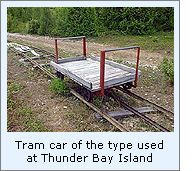 1884 was a year of welcome improvements
at the island, as a crew from the Detroit depot arrived to construct a
storm house around the door into the keepers dwelling, and to built an
iron-tracked tramway from the boat landing located a half mile west of
the station to the fog signal building. Equipped with a small cart, this
arrangement was no doubt considered a real boon by the keepers, who
previously been forced to laboriously transport tons of coal and
supplies by wheelbarrow or hand cart the half mile from the landing.
While District Inspector Commander Francis A Cook reported that he found
the base of the tower to be in deteriorated condition, and reiterated
Miller's previous recommendation that it be replaced as soon as
possible, no action was taken on the request. 1884 was a year of welcome improvements
at the island, as a crew from the Detroit depot arrived to construct a
storm house around the door into the keepers dwelling, and to built an
iron-tracked tramway from the boat landing located a half mile west of
the station to the fog signal building. Equipped with a small cart, this
arrangement was no doubt considered a real boon by the keepers, who
previously been forced to laboriously transport tons of coal and
supplies by wheelbarrow or hand cart the half mile from the landing.
While District Inspector Commander Francis A Cook reported that he found
the base of the tower to be in deteriorated condition, and reiterated
Miller's previous recommendation that it be replaced as soon as
possible, no action was taken on the request.
In one of the Great Lake's infamous
November storms, Huron unleashed her fury across Thunder Bay on November
27, 1889, and huge sweeping waves crashing across the island's surface,
scouring the surface of the island and carrying away everything that was
not permanently attached, including the tramway and cart. With other
construction projects taking precedence, a work party was not dispatched
to the island to make the necessary repairs until September 20, 1891, at
which time they also deepened the station's well and rebuilt the fog
signal machinery. With falling water levels throughout the lakes in the
mid 1890's, the boat ways along which the station's boat was hauled into
the boat house no longer reached into the water, and the ways were
extended in 1895 to once again allow the boat to be pulled to the safety
of the boat house during rough water.
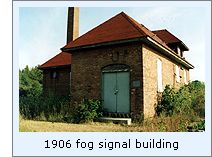 The dawning of the new century brought
a few years of relative peace at the station, with no significant
maintenance or construction projects being reported at the station until
1906, when a work party arrived on the island to replace the old wood
framed fog signal building with a new red brick structure. At the
completion of the work, the boilers and machinery were rebuilt and
transferred into the new structure. The following year, a work crew
poured 1,200 feet of cement walks connecting the station buildings, and
the underground wooden cistern in which rainwater was captured from the
roof was replaced with a concrete structure. It was also during this
year that station's fog signals were active for a station record of 444
hours, to the chagrin of the keepers who were required to shovel the 25
tons of coal required to keep a head of steam in the hungry boilers. The dawning of the new century brought
a few years of relative peace at the station, with no significant
maintenance or construction projects being reported at the station until
1906, when a work party arrived on the island to replace the old wood
framed fog signal building with a new red brick structure. At the
completion of the work, the boilers and machinery were rebuilt and
transferred into the new structure. The following year, a work crew
poured 1,200 feet of cement walks connecting the station buildings, and
the underground wooden cistern in which rainwater was captured from the
roof was replaced with a concrete structure. It was also during this
year that station's fog signals were active for a station record of 444
hours, to the chagrin of the keepers who were required to shovel the 25
tons of coal required to keep a head of steam in the hungry boilers.
The District Lampist was dispatched to
the island in 1913, and on May 21 upgraded the illuminating apparatus in
the Fourth Order lens from a kerosene-fueled lamp to a more efficient
incandescent oil vapor system, resulting in an increase in the light's
intensity to 5,600 candlepower and an increase in its visible range to
19 miles. At this time the light's characteristic was also changed to
flashing every 30 seconds. Things at the station remained steady for the
next ten years, with only minor maintenance being performed by the
keepers themselves. As a component of a system-wide upgrade, the
station's 30-year old steam whistles were removed from the signal
building in 1921, and replaced with "Type C" Diaphone
fog signals, and
the fog signal characteristic changed to a 30 second cycle, consisting
of a 2 second blast followed by 2 seconds of silence, a second blast of
2 seconds followed by 24 seconds of silence.
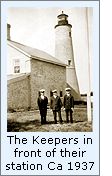 1932 saw the upgrading of the Diaphones
to the larger "Type F" to increase their effective audible
range, and after a surface coating of Portland cement was applied to
help weather proof the exterior of the tower in 1938, the tower was
given a coat of white paint, hiding the Cream City brick, and leaving
the station appearing virtually the same as it appears to this day. 1932 saw the upgrading of the Diaphones
to the larger "Type F" to increase their effective audible
range, and after a surface coating of Portland cement was applied to
help weather proof the exterior of the tower in 1938, the tower was
given a coat of white paint, hiding the Cream City brick, and leaving
the station appearing virtually the same as it appears to this day.
Responsibility for the nation's aids to
navigation was transferred to the Coast Guard in 1939, with the civilian
keepers given the option of either maintaining their existing position,
transferring into the Coast Guard, or resigning. Keeper William De Rusha
and his assistants James Mac Donald and Russell Perry all appear to have
chosen the resignation route, since their names disappeared from the
station's payroll records within a year of the takeover, their
responsibilities taken over by Coast Guardsmen.
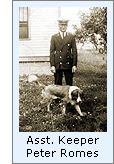 In 1983, the Thunder Bay Island Light
was one of the last on the lakes to be automated through the
installation of a 190 mm acrylic optic in the lantern, powered by an
array of solar cells located on the ground at the base of the tower and
a bank of storage batteries in the tower. After 151 years of hard and
faithful service the busy sound of keepers at work disappeared from the
island forever. In 1983, the Thunder Bay Island Light
was one of the last on the lakes to be automated through the
installation of a 190 mm acrylic optic in the lantern, powered by an
array of solar cells located on the ground at the base of the tower and
a bank of storage batteries in the tower. After 151 years of hard and
faithful service the busy sound of keepers at work disappeared from the
island forever.
The station sat empty for almost
fifteen years, its buildings quickly falling victim to the ravages of
the weather and mindless vandalism. While vandals did a considerable
amount of damage to the station's structures, their remote location
offshore likely served as the major reason that they were not completely
destroyed.
A group of local citizens concerned
with the survival of the historic structure gathered together to form
the Thunder Bay Island Preservation Society, and in 1997 signed a
10-year lease with the US Coast Guard for responsibility for the light
station's grounds and buildings. Members of the Society are currently
involved in restoring the station's buildings, and collecting
information on the island's history. They are in need of funds, and
anyone wishing to make a donation to assist them with their continuing
efforts is urged to contact the Society at the address provided below.

Keepers of
this Light

Click here
to see a complete listing of all Thunder Bay Island Light keepers compiled
by Phyllis L. Tag of Great Lakes Lighthouse Research.

Finding this
Light

 We expect to visit Thunder Bay Island personally at some time during
2003. For information on any tours being offered to the island, or to
make a donation to help with the restoration effort, please contact the
Thunder Bay Lighthouse Preservation Society at the following address:
We expect to visit Thunder Bay Island personally at some time during
2003. For information on any tours being offered to the island, or to
make a donation to help with the restoration effort, please contact the
Thunder Bay Lighthouse Preservation Society at the following address:
Thunder Bay Island Preservation Society
PO Box 212
Alpena, MI 49707
Click
here to email the society with any questions

Reference sources

Journals of the US House and Senate,
various, 1831-1867
Annual reports of the Lighthouse Board.
1853-1909
Annual reports of the Commissioner of Lighthouses, 1910-1929
Annual reports of the Lake Carrier's Association, 1907-1940
Great Lakes Light Lists, Various 1861-1977
Great Lakes Pilot, US Army Corps of Engineers, 1958
Great Lakes Pilot, NOAA, 2000
The Northern Lights, Charles K Hyde.
Recent photographs courtesy of Jeff Shook of Michigan
Lighthouse Conservancy
Photo courtesy of the US Coast Guard Archives.
Keeper listings for this light appear courtesy of Tom & Phyllis Tag

|
